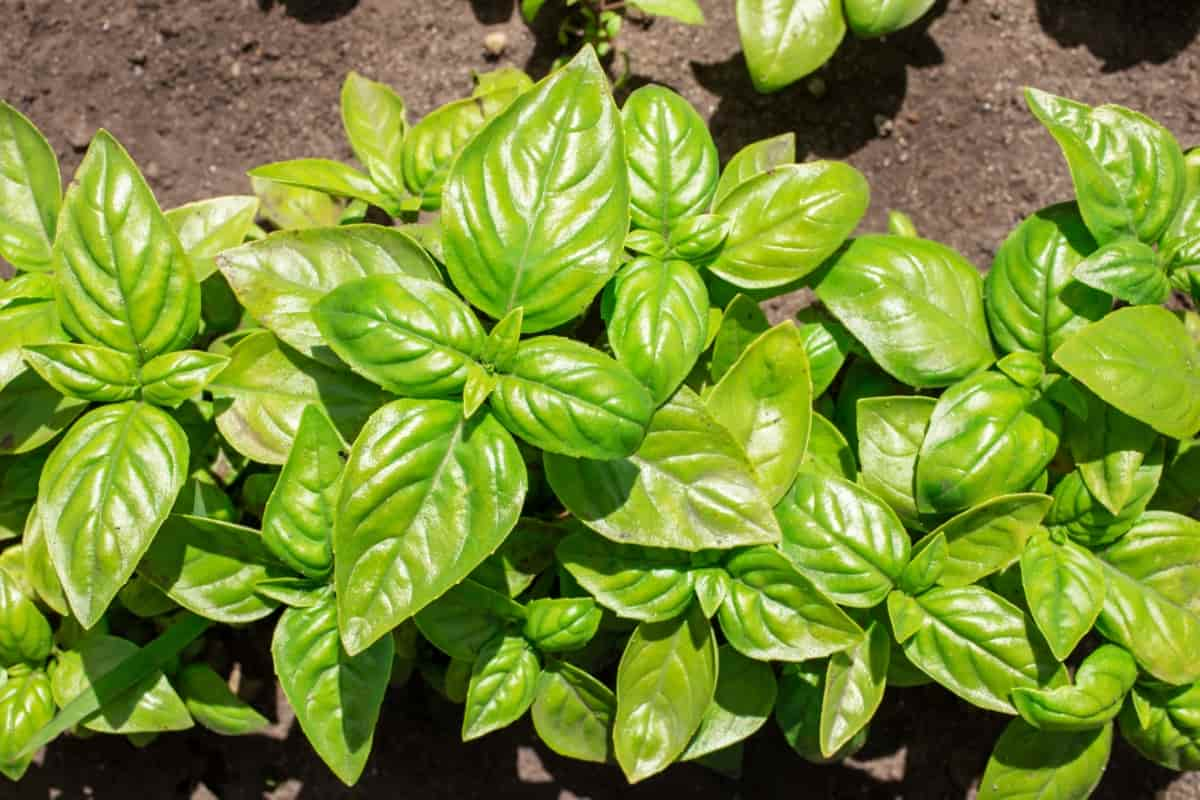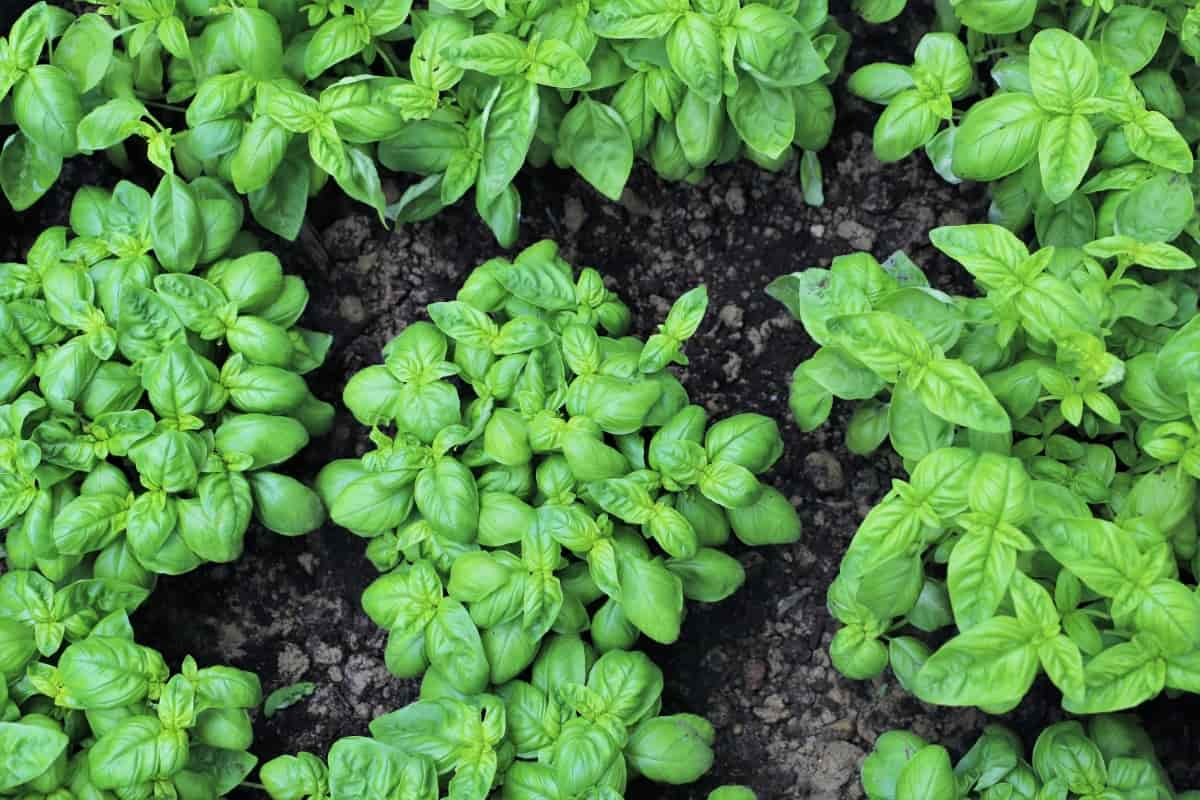The Basil plant is a popular kitchen or garden herb that is relatively easy to care for. Keeping your plants healthy will provide a continuous supply of fresh Basil if you prune and propagate them regularly. In this article, you’ll learn how to identify the problem and fix your Basil plant. Overwatering and underwatering are the common causes of Basil plant death. Many factors can cause a Basil plant to die, such as high temperatures, light problems, disease, and pests. Due to the annual nature of Basil plants, individual plants usually only last one growing season.

6 Causes of Dying Basil Plants
Overwatering
Basil plants die most often from overwatering. The roots of Basil plants are poorly adapted to cope with soggy soil, despite their preference for water. In overwatered Basil, the leaves will appear paler and yellowish, often starting from the lower leaves. Leaves wilt soon after, and you may notice an offensive odor coming from the soil.
You will see soggy soil and mushy, brown, or black roots when you remove the plant from its pot. If you notice the problem early, stop watering and let the soil dry out. You should pot your plant in an appropriate pot and soil. The plant should be watered once the soil dries out, but you should check the plant daily and only water after the soil has dried.
Underwatering
Fixing this problem may be the easiest thing you’ve ever done. If your Basil plant is not watered and the soil is dry, it will wilt badly and look very sad. Leaves may appear crispy and brown; you may see some leaf drop, and the pot will be very light to lift. Although Basil plants may appear to be dying, they usually recover very well. Make sure you water your Basil plant thoroughly to help it survive.
If your plant’s soil is dry, water it and place it in bright, indirect light rather than direct sunlight. Once the plant has perked up and new foliage has grown, you can replace it in direct sunlight and resume normal care. A good strategy to avoid underwatering is to check the water needs of your plants every day or two. Alternatively, you can grow your Basil in a smart or self-watering pot to automate the process.
Cold Damage
The Basil plant isn’t cold-hardy and will suffer greatly if exposed to frost. Plants will wilt when temperatures drop below 10°C. Due to reduced plant water requirements and lower evaporation, lower temperatures can also increase the risk of overwatering. When growing Basil inside, you rarely have temperature problems unless your plant is placed next to a drafty window. You should remove all frost risk before you sow seeds or move your plants outside to grow Basil.
In case you missed it: How to Grow Basil from Cuttings: A Complete Planting Guide for Beginners

Lighting Problems
Basil plants can sometimes die due to lighting problems. When you pick up a Basil plant for your kitchen herb garden, it’s easy to forget how important it is to provide optimal lighting. Full sun is ideal for Basil plants, so they should be placed in a west or south window. In the summer, full sun can be too much, so look for scorched or crispy leaves, indicating that you should move it away from the window.
You are more likely to find low light to be the cause of a dying Basil plant if a lighting issue causes it. Growth will be slow and leggy, and new leaves will be smaller or stunted under low light. When the light is low, your Basil plant arranges its chlorophyll in the leaves to catch as much light as possible. As a result, the leaves can appear more vibrantly green than usual, and you may think your plant is in perfect health.
Nevertheless, continued low light will eventually cause your Basil plant’s leaves to turn yellow, its lower leaves to brown, and its leaves to drop. Providing bright, indirect light is the next best thing if you can’t provide direct sunlight for your Basil plant. When you hold your hand up in bright, indirect light, your hand should cast a fuzzy shadow. There probably isn’t enough light for your plant without a shadow cast.
Due to Pot Choice
Basil plants from a garden center or supermarket usually come in small, thin plastic pots. Those small plastic pots, while inexpensive, are unsuitable for growing a healthy Basil plant over the long term. There is a problem with their size. A small pot has limited soil capacity, so it has limited moisture capacity. Due to the limited amount of soil there, it absorbs water quickly but dries out quickly as well.
Basil struggles to thrive in small pots because the soil can’t maintain consistent moisture for several days to a week. Ensure your pot is made of a natural material that stays cooler in the sun. Examples include terracotta, ceramic, clay, or stone. A diameter of 12 inches or larger and a depth of 4 inches or more is a good size. Still, you can grow a healthy plant in a small or plastic pot, but you will need to monitor the soil moisture more closely.
Pests
Not only Aphids, spider mites also are the most common culprits inside. In the garden, slugs can also pose a problem and lead to Basil plants’ death. Spider mites and aphids are both sap-sucking pests. Occasionally, you will see leaf spots where they have attacked the plant, and in severe infestations, the weakened plant will die from dehydration or opportunistic disease. The spider mite is very small and can multiply very quickly.
You can spot bugs by looking closely at both sides of the leaves for wisp-like webs between the foliage. Insects such as aphids are larger and can be easily spotted. Consider isolating affected plants for treatment if the problem escalates to infestation. Infestations on weakened plants can spread to healthy neighbors that would otherwise be able to resist them.
In case you missed it: Basil Plant Care: 10 Reasons Why Your Basil Plant is Wilting and How to Solve It

Consider extra prevention efforts and pay close attention to your nearby plants. It may seem that chemical pesticides are the most direct solution, but many natural treatments are just as effective and have fewer toxic environmental effects. Organic pest management methods have been developed in recent years with better long-term results.
Conclusion
When Basil plant droops from underwatering, it will usually recover quickly once watered properly, but it may be harder to revive your plant from other causes. If your Basil plant is dying for some reason, the solution will vary depending on the cause. You must carefully examine your plant and its growing conditions before attempting to revive it.
- Ultimate Guide to Ossabaw Island Hog: Breeding, Raising, Diet, and Care
- Ultimate Guide to Juliana Pig: Raising Facts, Size, Diet, Care, and Lifespan
- Raising Lleyn Sheep: Disadvantages, Price, Uses, Characteristics, and Care
- Ultimate Guide to Meishan Pig: Breed Facts, Breeding, Raising, and Care
- Ultimate Guide to Teacup Pigs: Raising, Diet, Lifespan, Cost, and Care
- Guide to Raising Poll Dorset Sheep: Facts, Profile, Characteristics, Uses, and Care
- Ultimate Guide to Bighorn Sheep: Characteristics, Diet, Lifespan, Breeding, and Lifecycle
- Ultimate Guide to Raising Katahdin Sheep: Farming Facts, Breed Profile, Uses, and Care
- Ultimate Guide to Raising Oreo Cows: Belted Galloways Farming Facts, Profile, Uses, and Care